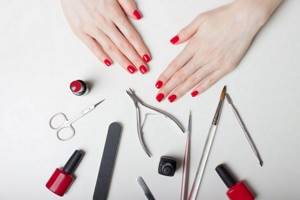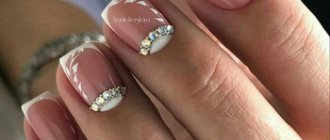Do you want to become a nail artist? Get ready to face harmful manicure dust!
Leave your contacts and we will tell you how to avoid it using Tornadel!
Thank you! We will contact you shortly.
Choose a hood that suits you 100%
To catalog
All March
Free delivery with promo code “0803”
To catalog

Where to begin?
If you decide to become a nail service master, you need to clearly determine what it is for and whether this work is right for you.

To the first question, as a rule, girls give one of two answers: for earnings or for beauty. And if the craving for beauty and the desire to ennoble ladies’ nails will allow you not to lose your ardor for years, then a purely pragmatic calculation will quickly drive you into a dead end. The fact is that the initial stage of working in the nail industry is especially difficult: the work is hard, it takes a lot of time, and there is practically no income. And it will be difficult to cope with huge competition without equipment and skills.
You can find out whether you like this or that business only through practice, but you can form an approximate opinion now. Thus, the masters we interviewed said that to work with marigolds you need:
- Live your own business. If you spend your free time looking at inspiring nail decor ideas, learning new techniques, and following industry news, work will not be a burden to you.
- Be careful and diligent. With some types of manicure, for example, French or moonlight, you will have to work hard - one awkward move and everything will have to be redone. To prevent work from turning into hell, you must have a penchant for painstaking and scrupulous work.
- Be able to get along with people. Manicurists are subtle psychologists. In parallel with performing your direct duties, you need to create a favorable psychological environment: chat with one client, listen to the second, and just sit in silence with the third.
- Maintain discipline. You will have to keep track of time in order to manage to serve more than 1 client per day and manage your schedule.
Do you want to become a nail artist? Get ready to face harmful manicure dust!
Leave your contacts and we will tell you how to avoid it using Tornadel!
Thank you! We will contact you shortly.

Staff
Customer loyalty—and therefore your income—depends on the level of service. Therefore, do not hire people on staff without making sure of their qualifications.
Criteria that the candidate must meet:
- education in the specialty, availability of a resume;
- availability of a health certificate with a completed medical examination;
- politeness, neat appearance;
- Diplomas from competitions, certificates of master classes will be advantages.

Table No. 4. A list of employees:
| Job title | Amount of workers | Salary (rub.) |
| Administrator (2 shifts) | 2 | 40 000 |
| Accountant (outsourced) | 1 | 6 000 |
| Master | 3 | 75 000 |
| Cleaning lady (several hours a day) | 1 | 5 000 |
| Total: | 126 000 |
How long does it take to study and how much does it cost?
You can and should learn the art of nail treatment all the time, but basic knowledge can be gained in a relatively short period of time. You can learn the basics of proper cuticle treatment, nail shaping, plate extensions, high-quality finger care, as well as various designs in an average of a couple of weeks. Then you can devote 2-3 months of continuous practice with models and now you can proudly call yourself a manicurist.
By typing a query about manicure courses into a search engine, you will see a whole bunch of offers. But let’s not throw ourselves into the pool headlong and learn how to structure these sentences.
Business risks
- High competition. To attract a central office, you will have to introduce new technologies, promotions, special offers, and develop strategies for retaining your client base.
- It is necessary to constantly monitor the level of service. One dissatisfied customer will cause significant damage to your business.
- High qualification requirements. The field is becoming more complex, new standards are emerging - it is important to keep up with the latest trends. The professionalism of the master determines the loyalty of the audience.
- Difficulties with procurement. The niche is full of unscrupulous manufacturers and suppliers, so caution is required.
Studio training
Perhaps the best option for developing skills. During the courses you will be able to calmly ask questions, learn new things, follow the practice of masters, work under their guidance - in general, closely learn from experience.

However, today almost every studio offers its own training course. How to choose the best? We advise you to pay attention to a number of factors:
- Reviews and works of masters and students. A big name, promises, advertising slogans - all this is easy to come up with and buy. Don’t be fooled by words, get to know the results: where and how former students work, how they respond to the course. It is also worth getting acquainted with the teaching staff and assessing the level of skill.
- Number of students. Find information on how many students have completed these courses to determine whether they are in demand. It is also worth finding out in advance what the size of the group is: the more students there are, the less attention they will pay to you. But you want to get the most out of your investment, don’t you?
- Contents of the program. Beginning masters should not grab hold of complex technologies; they should first get a strong base. If you are promised to conquer classic manicure, European care, and hardware technology, run as far as possible from such a unfortunate school.
- Certificate with wet seals and signatures. Anyone can print out a colorful piece of paper with the proud name “Certificate”, but not everyone is ready to bear responsibility for the quality of your training.
Choose a hood that suits you 100%
To catalog
History of the origin of the profession
The formation of the profession goes back to the history of Ancient Egypt. During excavations of one of the tombs, the remains of Hanumhotep and Niankhanum, representatives of the retinue of Pharaoh Nuser, were found. They bore the title of “masters and guardians of nails” of the great ruler.
There was no gender difference for manicure; it was done by both women and men. For example, in ancient times, warriors had a tradition of decorating their bodies and nails in order to emphasize strength and courage. Legionnaires of Ancient Rome painted the first phalanges of their fingers with scarlet paint in order to maintain morale.
In ancient China, they believed that long nails were an indicator of wisdom. The Chinese grew their nail plates and painted them. They made varnish from natural ingredients such as egg yolk and wax. Varnishes based on gold and silver gained popularity, and during the reign of the Ming Dynasty, varnishes in red and black colors became popular.
In Rus', manicure was associated with paganism. People believed that nails should be cut on Thursday, otherwise the gods would send illnesses. They burned the scraps to avoid becoming victims of evil spirits. The purpose of manicure in the 21st century. There is only one left - aesthetic.
How to become a successful manicurist yourself?

On social networks, YouTube and thematic blogs you can find a lot of educational information on manicure. Why take courses and spend money when you can just collect it?
Yes, self-study is a real opportunity to master the intricacies of creating a manicure. Having set a goal, you can watch videos, read articles and look at pictures for a couple of weeks, and then start practicing. So, you will master basic skills and be able to give a decent manicure to yourself, your family and friends.
However, you can forget about working in a salon or studio - without serious preparation or at least extensive practice, you will not be allowed there. Also, you are unlikely to be able to sell your services, since most clients are interested in the availability of supporting documents and equipment from the masters.
If you are ready to become a master only for your friends, you can save money and train yourself. If nail service is an opportunity to earn money for you, you will have to forget about self-training.
List of tools required for manicure:

- Tweezers
- Cuticle scissors
- Tweezer scissors
- Device for hardware manicure
Since manicure is called “hardware”, it means that it requires a special device. Today there are a large number of devices on the market, however, the choice must be taken very carefully. You should not choose the cheapest device; it is better to pay extra and calmly work on high-quality equipment that will not let you down.
The set should include special cutters for manicure and gel polish removal.

You won't be able to start working without lamps. You need at least one lamp to illuminate your workplace, and the second to dry gel polish. When purchasing an LED lamp you need to pay attention to:
- lamp power (power must be at least 48 W);
- the bottom of the lamp must be removable;
- the light bulbs inside the lamp should be located evenly around the entire perimeter of the device;
Types of coating

- Base coat (there are two types of bases: rubber - more durable, and camouflage - it can be used without further coating with gel polish, it itself has a color);
- Gel polish (now there is a large selection of gel polishes for every taste and budget);
- Top coat (necessary for fixing the gel polish; there are several types of top coat: glossy, matte and with glitter);
- Cuticle oil;
Additional funds
- Antiseptic (necessary to disinfect hands);
- Primer (a product that promotes better bonding of gel polish to the nail);
- Degreaser;
- Files;
- Polishing file - buff;
- orange sticks;
Items needed for work
- Desk (you need to choose a table based on your needs and the size of the room);
- Chair or armchair (for the master and for the client);
- Rack or cabinet (to properly organize your workspace);
- Palm rest;
- Manicure hood (our company Tornadel offers a large selection of hoods that will suit every taste and budget);
- Artificial lighting (without light it is impossible to do a high-quality manicure);
- Cabinet;
The target audience
The main audience (95%) are women aged 16 to 50 years. Basically, they work and visit the salon from 1 to 4 times a month (depending on needs and income level). A separate subgroup is the non-working population (mothers on maternity leave, housewives, students). 5% of the entire target audience are men.
To make it easier to create a set of services and tools for their promotion, we will draw up a portrait of the client. It is important to consider:
- life style;
- wage level;
- preferences;
- needs;
- values.
Conduct an in-depth analysis and collect the following information:
- Full name, contact details;
- date of first visit to the salon;
- total number of visits;
- optimal time to visit;
- the client’s opinion about the quality of services and the salon as a whole;
- what craftsmen served the client.
This is how the regular clientele is determined, the degree of their loyalty to the salon, and the quality of the employees’ work is monitored. This information is invaluable when developing a strategy to attract and retain your customer base.
What is necessary for client safety?
It goes without saying that all instruments and work items must be sterile. Your workplace should be clean.
To do this, it is necessary to disinfect work surfaces, tools, lamps, etc. after each client.
In addition, the master must work in a mask and gloves, which will protect him from small particles of dust and toxic chemical fumes getting into his eyes and respiratory tract.
Use special disinfection baths and sterilizers.
Treated tools can be stored in craft bags.
Room
The location and area of the room depend on the format. It is better to open a salon and manicure office in high traffic areas - in the central part of the city, near public transport stops and intersections in residential areas, in shopping centers.
The nail studio must meet sanitary requirements:
- availability of cold and hot water supply;
- the area of one workplace is not less than 4.5 m²;
- utility room;
- separate rooms or areas for manicure and pedicure;
- high-quality ventilation system;
- a room for cleaning and sterilizing instruments (instruments and furniture are disinfected after each client appointment).
You can study the requirements in more detail in Resolution No. 59 dated May 18, 2010 “On approval of SanPiN 2.1.2.2631–10.”
For 3 workplaces (2 for manicure work and one for pedicure work) you will need at least 30 m². The area is designed for work areas, utility rooms and a foyer where visitors will wait their turn. Our business plan for a manicure salon involves renting a one-room apartment on the ground floor. The average rental price in Russia is 25,000 rubles. Repairs will require 30,000 rubles.

How to find clients?

The first thing you need to do is get your teeth in, which is why usually your first clients are: relatives, friends, acquaintances, and so on. Then word of mouth will start working for you, and if you really do a high-quality manicure, new clients will not keep you waiting.
It is not necessary to immediately get a job in a salon or rent an office; you can start working at home by equipping a separate work area there.
Also, at first, new clients may be attracted by the low cost of your services, but remember that over time you will become more experienced, expand your portfolio, and, accordingly, the price of manicure will need to be raised.
We also must not forget that we live in an age of high technology and we need to use it wisely. You can place advertisements for the provision of services on Avito, Yula, or in certain communities on social networks.
You can print out business cards and distribute them to your friends, who will be able to tell their other friends about you, the main thing is not to be afraid to start.
If you feel confident, then you can get an internship at a salon where there is already a ready-made client base, and all you have to do is prove yourself.
Opening a nail salon at home
How to make money doing manicures if you decide to open your own individual entrepreneur? The first step is to register yourself as an individual entrepreneur with the tax service. To create a manicure salon, the same code is used as for hair salons. Next, you pay the receipt, collect the package of necessary documents and file them with the tax office.
After all the paperwork, you should decide on the taxation system. You can choose for yourself UTII or simplified tax system. The second option is much simpler and clearer, so it’s better to stick with it.

When your individual entrepreneur is officially registered and registered, you have to buy a cash register directly from the tax authorities. You will have to wait about 20 days for such a device, so plan your work in advance, taking into account the waiting period.
If you need the device urgently, then there are special services that sell cash registers that will deliver the device to you in just 3 days, but it costs much more.
Also, when registering an individual entrepreneur, do not forget to order a stamp; it is needed in any business, regardless of your income or expenses. There is no way around this moment.

Advantages and disadvantages of work
The Instagram accounts of nail artists shine: photos of luxurious ladies, neat workspaces with a bunch of equipment, screenshots with reviews from grateful clients. How can you not be envious and quit your disgusting job in a drab office? But these accounts hide hard work, which has its pros and cons. By getting to know them “on the shore,” you will save yourself from severe disappointment.
Benefits for which you can do a manicure:
- Demanded trade. Well-groomed nails are an essential attribute of a modern woman who cares about her image. Schoolgirls, students, mothers, working women - each master has his own audience.
- Short-term training and its low cost . After completing a two-week course and gaining basic knowledge, you can safely start accepting clients. Then all that remains is to improve your qualifications.
- Flexible work schedule . This point applies more to self-employed artists, since nail studio workers are often deprived of this privilege. Single masters themselves decide when to accept a client and when to take a day off.
- Realization of creative potential. If you have always dreamed of creating, rejoice, now your works are distributed throughout the city and region.
- Opportunity to meet interesting people. A good master is a friend to his clients. Today you painted the nails of a famous lawyer, and tomorrow she has already helped draw up an important contract.
- Stable influx of clients. If you win the client’s trust, she will visit you regularly, whereas in other areas of the beauty industry such consistency can only be dreamed of.
But working as a manicurist also has its disadvantages , which few people notice:
- Harmful to health. While working, you will almost always be in a bent position, bending over your nails. You will also have to constantly inhale vapors from the compounds and dust from nails and filed manicures. When working on a design, you will have to constantly strain your eyes. The load comes from all sides, but you can cope with it by purchasing a comfortable chair and table, an extractor hood and a mini vacuum cleaner, a good lamp and safety glasses.
- Large financial investments at the start. To get started, you will have to purchase a basic collection of colored varnishes, primaries, bases, fixatives, dryers, tools, a couple of correction devices and much more. All this costs a lot of money and takes a long time to pay off.
- The need for constant development. Fashion is constantly changing, new techniques and new tools appear. Clients will not support your conservatism and will go to other masters.
- Excessive busyness. This catch awaits experienced craftsmen who have already gained a clientele. The dream of an experienced master is a full day off, when not a single client will need correction. But how can I refuse them - all my clients are my own, my family.
- Ungrateful, conflictual and problematic clients. Where would we be without brawlers, deceivers and outright fools - the nail industry is not left without them. Sometimes you have to come into contact with very aggressive and negative individuals, and you need to learn this.
Tips for beginners

- You must smile, be friendly and polite, despite your mood or any personal problems or worries. People come to you for beauty, and not to ruin their mood.
- Distribute your working time correctly. Give yourself time to rest. Don’t chase the number of clients; it’s better to relax a little and do quality work than to work under a constant deadline.
- Your workplace should be perfectly clean. There simply cannot be chaos.
- A novice master should look attractive. Whatever one may say, a person is greeted by his clothes, so you must be perfect, starting with your hairstyle and ending with your nails. Beauty attracts and disposes.
- You need to constantly monitor new trends and be aware of the latest fashion trends.
- In your speech, you must adhere to an easy communication style; you must be ready to listen to the client, even if he criticizes you or talks about his personal problems and experiences. Many ladies come to manicures to share and talk about painful issues.
- A real master must have a portfolio that will be constantly updated.
- Never skimp on materials and equipment; the quality of your work depends entirely on them.
Is it worth working on a franchise?
When opening an office under a franchising scheme, the franchisor takes on a huge share of the tasks. This includes developing a business plan, searching for premises, repair and design work, purchasing equipment and materials, and advertising. The franchisor has experience and a supplier base - therefore, you will save time, money and get rid of the risk of running into the pitfalls that await a newcomer on the path to creating a startup from scratch. Support is usually provided at all stages - from registration to organizing work processes. A ready-made, practice-tested model guarantees income.
The downside of a franchise is the need to give away part of the profit every month.
What should a good master be like?
When starting training, identify for yourself a specific measurable goal - the image of the master you want to become. We talked with experienced craftsmen and identified what skills and knowledge they use in their work - this will allow us to form an abstract image of a master of his craft.

- Serious theoretical basis . The manicure course begins with the theory of biology: studying the structure of the nail plate, the causes of defects and diseases, and ways to eliminate them. Knowledge about skin types and color palettes will also come in handy. The theory of manicure is further based on this knowledge: technologies for caring for native and extended nails, methods for their correction, methods of working with tools and modeling various nail shapes.
- Rich practice . If you easily draw on tips, this does not mean at all that you will be able to paint on nails. An experienced master can work with problematic nails, and with the work of other masters, and in a limited time. All this comes with practice.
- Knowledge of fashion trends and good taste . An experienced master should not expect that a client will come to him with a photo of her future manicure, and he will only redraw someone else’s work. He must be able to select a design, color, shape to suit the client’s appearance and clearly justify his choice. This periodically requires knowledge of current fashion trends.
- A formed set of tools and means . Each scissors, file and cutter is special for the master. Before gathering his “comrades in arms,” he tried many analogues and now he knows exactly what the advantages of his arsenal are.
- He is sensitive to hygiene . A clean table, sterile instruments, ironed uniform, disposable gloves and a well-thought-out disinfection system are the calling cards of a good master.
- Knows how to create a cozy atmosphere. A good master does not ask the client to relax, but does everything to make him do it voluntarily: he puts a pillow under his arm, turns on relaxing music, offers tea and coffee, and maintains a casual conversation.
Learn, practice, try new things and sooner or later you will see that your idols are gradually becoming your competitors.
A good master always cares about the health of his clients, and Tornadel will help him with this
To order, leave your contacts and we will call you back:
Thank you! We will contact you shortly.
Equipment
Table No. 1. Furniture for a manicure room:
| Furniture | Cost, rub.) |
| Chairs for craftsmen | 30 000 |
| Chairs for clients | 30 000 |
| Manicure table (height no lower than 70 cm) | 10 000 |
| Racks for storing tools and consumables | 8 000 |
| Reception desk | 5 000 |
| Sofa for visitors | 10 000 |
| TV for the hall | 6 000 |
| Pedicure chair | 30 000 |
| Cooler | 3 000 |
| Total amount: | 132 000 |
Table No. 2. Equipment for manicure salon:
| Equipment | Cost (Russian rubles) |
| UF lamps for building and drying gel polish | 2 000 |
| Sets for manicure and pedicure | 6 000 |
| Sterilization equipment | 3 000 |
| Milling cutter for manicure and pedicure | 6 000 |
| Baths, coasters and pillows | 8 000 |
| Paraffin furnace | 3 000 |
| Nail brushes | 1 000 |
| Lamp | 2 000 |
| Manicure hood | 4 000 |
| Total amount: | 35 000 |

Table No. 3. Materials for the manicure salon:
| Materials | Cost (Russian rubles) |
| Palettes of varnishes, gel polishes | 10 000 |
| Products for removing nail polish/shellac, softening cuticles, etc. | 10 000 |
| Care products | 6 000 |
| Napkins, gloves, etc. | 3 000 |
| Total amount: | 29 000 |











